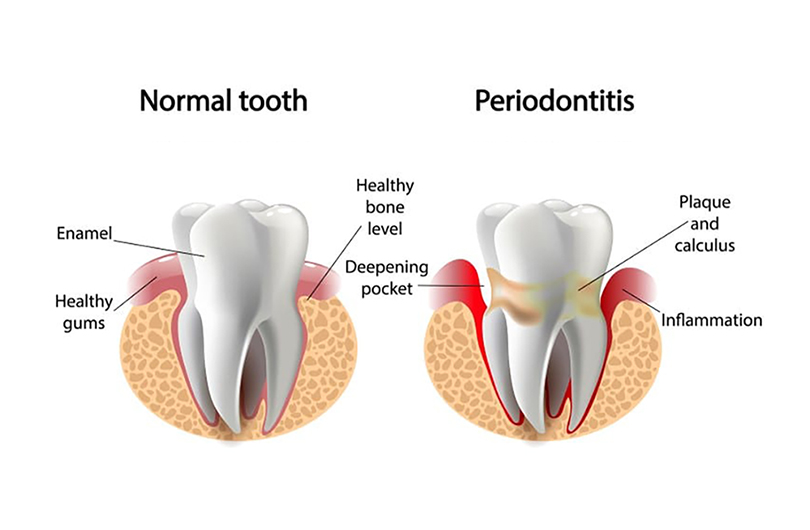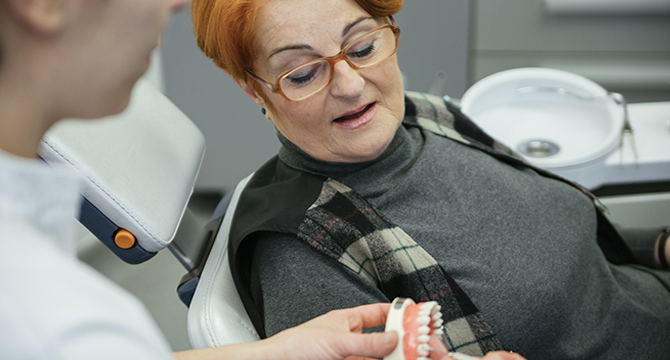Periodontics
Specializing in prevention, diagnosis and treatment of periodontal disease, gingival surgeries and placement of dental implants.
About Periodontics
Periodontics is the dental specialty that focuses exclusively on the inflammatory disease that destroys the gums and other supporting structures around the teeth. Periodontists treat cases ranging from mild gingivitis to more severe periodontitis. Monument Endodontics & Periodontics offers a wide range of periodontal treatments, including: scaling and root planing (the cleaning of infected root surfaces), root surface debridement (the removal of damaged tissue), and regenerative procedures (the reversal of lost bone and tissue). When necessary, periodontists can also perform surgical procedures for patients with severe gum disease. Additionally, periodontists are trained in the placement, maintenance and repair of dental implants.
What is a periodontist?
A periodontist is a dentist who specializes in the prevention, diagnosis, and treatment of periodontal, or disease, and in the placement of dental implants. In addition to their general dentistry education, they receive up to three additional years of specialized training in periodontal disease treatment in both non-surgical treatments and periodontal plastic surgery procedures. As specialists in periodontal disease, they are experts in the latest techniques for diagnosing and treating periodontal disease. They are also trained in cosmetic periodontal procedures.
Treatments Offered
- Non-surgical Treatments
- Gum Graft Surgery
- Regenerative Procedures
- Dental Crown Lengthening
- Dental Implants
- Pocket Reduction Procedures
- Plastic Surgery Procedures
Frequently Asked Questions About Periodontics
Other than diagnose and treat gum disease, what else have periodontists been trained to do?
Most periodontists spend the majority of their time diagnosing and treating gum disease, but there are a variety other procedures that they are able to perform. Periodontists place dental implants when natural teeth cannot be saved. They also monitor the implants to make sure that they’re properly doing their job. Periodontists may also correct gum recession and cover up exposed root surfaces which can be unsightly as well as sensitive to hot and cold. These procedures are often used to lay the foundation for additional cosmetic procedures to help create a beautiful smile. Finally, periodontists can be integral in the comprehensive planning of your oral care, along with your general dentist or other dental professional.
What are common signs and symptoms of periodontal disease?
Periodontal disease is often silent, meaning symptoms – particularly pain – may not appear until an advanced stage of the disease. However, you should still be on the lookout for the signs and symptoms, which include:
- Red, swollen or tender gums or other pain in your mouth
- Bleeding while brushing, flossing, or when eating certain foods
- Gums that are receding or pulling away from the teeth, causing the teeth to look longer than before
- Loose or separating teeth
- Pus between your gums and teeth
- Sores in your mouth
- Persistent bad breath
- A change in the way your teeth fit together when you bite
- A change in the fit of partial dentures
If you notice any of these symptoms, be sure to contact your dentist or periodontist right away!
What can I do at home to prevent periodontal disease?
The best way to prevent periodontal disease is to take good care of your teeth and gums at home. This includes brushing your teeth after every meal and before bedtime, flossing at least once each day, and seeing your dentist or periodontist for regular exams twice a year. Spending a few minutes a day on preventative measures may save you the time and money of treating periodontal disease!
Who should treat my periodontal disease: my general dentist or a periodontist?
Instead of leaving your treatment to one dental professional, you should consider having both your general dentist and a periodontist be actively involved in the diagnosis and treatment of your periodontal disease. This team approach will help your general dentist (who is familiar with your dental and medical history) and your periodontist (who has extensive experience treating periodontal disease) collaborate to tailor a treatment plan that works best for your individual case.
I was recently diagnosed with periodontal disease. How often should I see my periodontist for an examination?
Most periodontists spend the majority of their time diagnosing and treating gum disease, but there are a variety other procedures that they are able to perform. Periodontists place dental implants when natural teeth cannot be saved. They also monitor the implants to make sure that they’re properly doing their job. Periodontists may also correct gum recession and cover up exposed root surfaces which can be unsightly as well as sensitive to hot and cold. These procedures are often used to lay the foundation for additional cosmetic procedures to help create a beautiful smile. Finally, periodontists can be integral in the comprehensive planning of your oral care, along with your general dentist or other dental professional.


